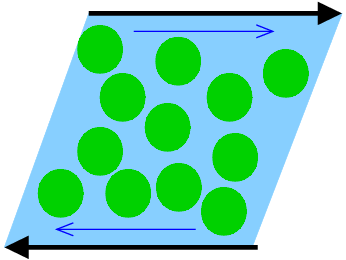 |
Research Topics | 
|
 |
Research Topics | 
|
‘Soft Matter’ comprises many important materials in every day use, such as colloidal dispersions, emulsions, liquid crystals and polymeric materials. Proteins, cells, and other constituents of living organisms have many properties in common with these technological substances. Soft matter systems are characterized by collective phenomena which occur at very low frequencies. Elastic deformations require forces orders of magnitude smaller than in conventional crystalline solids, and thermal fluctuations play a dominant role. Soft matter thus is a testing ground for advancing ‘Statistical Physics’, and provides many model systems for the investigation of fundamental topics.
In our group, we develop first principles approaches in the frame of Statistical Physics and the classical ‘Theory of Many Body Systems’, in order to understand structural and transport properties of novel soft matter systems, especially far from thermal equilibrium. Presently, we investigate meta-stable, glassy states in colloidal dispersions and polymer melts, and their rheological properties (viz. flow properties, and/or behaviour under large deformations). We find, for example, universal scaling laws at non-equilibrium transitions between solid and liquid states, which rationalize the technologically important behaviour of dense dispersions, clays, ceramics, and amorphous plastics.
Colloidal particles (viz. sub-micrometer sized particles) dissolved in a liquid exhibit phase diagrams familiar from molecular systems. Yet, often they form metastable states which are very long lived and suppress relaxation into thermal equilibrium. Figure 1 shows the states diagram of a dense solution of spherical particles where addition of polymers induces a short ranged attraction. The volume fraction measures the volume taken by the particles relative to the total volume, and rcp marks ‘random close packing’. Polymer concentration measures the strength of the attraction, which has a range of approx. 8% of the particle diameter; cp thus plays the role of an inverse temperature. While equilibrium phases are observed in the non-shaded regions in Figure 1, states in the shaded regions are stuck in metastable gel and glass states for weeks or even longer. Because of their excessively large viscosity, processing and handling of these states proves impossible. Our prediction of two different glassy states, one driven by steric hindrance, the other by attraction, of glass-to-glass transitions, and of a region where increase of the attractions (equivalent to lowering the temperature) melts the glass, had been unexpected. Its verification in the shown experiments from Edinburgh has opened the route to tailoring metastable states by tuning the local fluid packing (called ‘cage effect’). In the SFB 513, we cooperate with the Maret group to understand vitrification of planar layers of colloids along these lines.
A single Brownian particle performing random motion was the starting point for the understanding of stochastic processes in Statistical Physics, initiated by Einstein, Perrin and others. Equilibrium properties of Brownian particles were largely understood in the second half of last century. The Transregio SFB TR6, where a number of groups from Konstanz participate, now uses ‘Colloids in External Fields’ to gain a fundamental understanding of many body systems far from thermal equilibrium. We cooperate with the experimental group Egelhaaf from Düsseldorf and investigate the behaviour of metastable states under strong driving with external non-conservative forces. These disturbances, for example a solvent shear flow, violate ‘detailed balance’ leading to stationary distribution functions which are not of Boltzmann-Gibbs type, and where the classical equilibrium fluctuation dissipation theorems do not hold. In the Konstanz IGK ‘Soft Matter’ we study the resulting flow behaviour of dense dispersions under stationary shearing, which exhibit the technologically very important effect of ‘shear thinning’. Figure 2 shows the viscosity of novel core-shell particles from the Ballauff group in Bayreuth, whose size varies with temperature. Varying the shear rate, viz. the magnitude of the velocity gradient measured by the Peclet number Pe0, a decrease of the solution viscosity by orders in magnitude can be observed. It is connected to the non-equilibrium transition between a yielding solid and a viscous fluid, situated at ca. 18°C in this sample, and is crucial for the application of a wide class of complex fluids like dispersion paints or tooth paste.